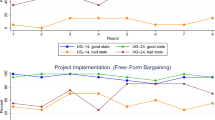Abstract
Trade requires search, negotiation, and exchange, which are activities thatabsorb resources. Thispaper investigates how different trade networks attend to these activities.An artificial marketis constructed in which autonomous agents endowed with a stock of goods seekout partners,negotiate a price, and then trade with the agent offering the best deal.Different trade networksare imposed on the system by restricting the set of individuals with whom anagent cancommunicate. We then compare the path to the eventual equilibrium as well asthe equilibriumcharacteristics of each trade network to see how each system dealt with thetasks of search,negotiation, and exchange.Initially, all agents are free to trade with any individual in the globalmarket. In such a world,global resources are optimally allocated with few trades, but only after atremendous amount ofsearch and negotiation. If trade is restricted within disjoint localboundaries, search is simple butglobal efficiency elusive. However, a hybrid model in which most agents tradelocally but a fewagents trade globally results in an economy that quickly reaches a Paretooptimal equilibriumwith significantly lower search and negotiation costs. Such ’small-world‘networks occur innature and may help explain the ease with which most of us acquire goods fromaround theworld. We also show that there are private incentives for such a system toarise.
Similar content being viewed by others
References
Albin, P. and Foley, D. (1992). Decentralized, dispersed exchange without an auctioneer. Journal of Economic Behavior and Organization, 18, 27–51.
Axtell, R. (1998). On the complexity of exchange. In Working Notes: Artificial Societies and Computational Markets. Autonomous Agents’ 98 Workshop, Minneapolis/St. Paul (May).
Bell, A.M. (1998). Bilateral trading on a network: A simulation study. In Working Notes: Artificial Societies and Computational Markets. Autonomous Agents’ 98 Workshop, Minneapolis/St. Paul (May).
Epstein, J.M. and Axtell, R. (1996). Growing Artificial Societies: Social Science from the Bottom Up. Brookings Institution Press, Washington D.C.
Feldman, A. (1973). Bilateral trading processes, pairwise optimality, and Pareto optimality. Review of Economic Studies, XL(4), 463–473.
Ioannides, Y.A. (1997). Evolution of trading structures. In W. Brian Arthur, Steven Durlauf, and David Lane (eds.), The Economy as an Evolving Complex System II, 129–168. Santa Fe Institute Studies in the Sciences of Complexity, Proceedings Volume XXVII, Addison-Wesley.
Jackson, M.O. and Wolinsky, A. (1996). A strategic model of social and economic networks. Journal of Economic Theory, 71, 44–74.
Kirman, A. (1983). Communication in markets: A suggested approach. Economic Letters, 12, 101–108.
Kirman, A., Oddou, C. and Weber, S. (1986). Stochastic communication and coalition formation. Econometrica, 54(1), 129–138.
McFadzean, D. and Tesfatsion, L. (1999). A C++ platform for the evolution of trade networks. Computational Economics, 14, 109–134.
Tesfatsion, L. (1997). How economists can get Alife. In W. Brian Arthur, Steven Durlauf and David Lane (eds.), The Economy as an Evolving Complex System II, 533–565, Santa Fe Institute Studies in the Sciences of Complexity, Proceedings Volume XXVII, Addison-Wesley.
Watts, D.J. and Strogatz, S.H. (1998). Collective dynamics of ‘small-world’ networks. Nature, 393(4), 440–442.
Author information
Authors and Affiliations
Rights and permissions
About this article
Cite this article
Wilhite, A. Bilateral Trade and ‘Small-World’ Networks. Computational Economics 18, 49–64 (2001). https://doi.org/10.1023/A:1013814511151
Issue Date:
DOI: https://doi.org/10.1023/A:1013814511151




